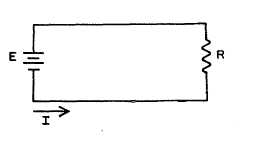|
| |
TM 9-254
CHAPTER 7
ELECTRONIC DATA
Section I. BASIC LAWS AND FORMULAS
7-1.
General.
This section defines the basic laws and formulas used in electronic theory. For clarity the section has been divided into
two parts, one addressing direct current (DC) and the other addressing alternating current (AC).
7-2.
Direct Current.
a.
General. Direct current or DC is the flow of electrons from a point of low potential to a point of high potential.
Typical sources of DC would be a flashlight or automobile battery.
b.
Ohm’s Law for DC Current. Developed by George Simon Ohm in 1827, this law states that the current
flowing in a circuit is directly proportional to the applied voltage and inversely proportional to the circuit resistance. Figure
7-1 shows the three forms of this law as related to the simple DC circuit provided.
I
=
R
E
E
=
IR
R
=
I
E
Where:
I is the current in amperes
E is the voltage in volt
R is the resistance in ohms.
Figure 7-1. Ohm’s Law for DC Circuits
c.
DC Power. Power is a measure of the energy expended in a circuit when the current flows through a
resistance. Power is measured in watts and can be determined by the following formulas:
P
=
IE
P
=
I2R
P
=
R
E2
Where:
P is the power in watts.
E is the voltage in volts.
I is the current in amperes.
R is the resistance in ohms.
7-1
|

